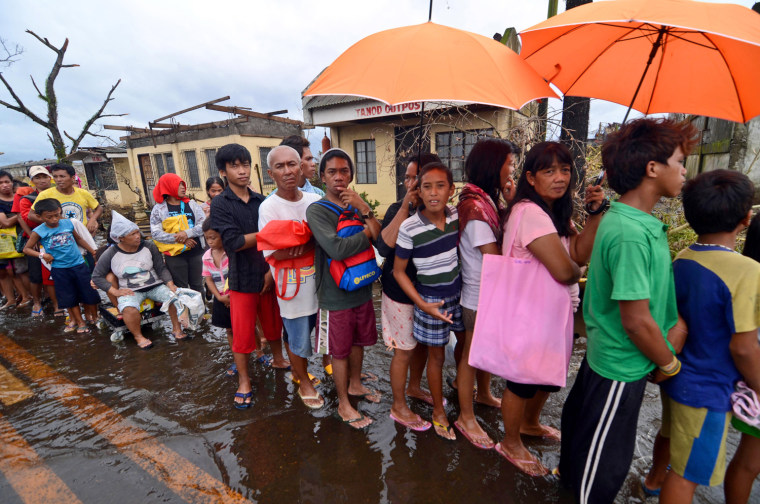Four days after a massive cyclone tore through the Philippines, increasingly desperate survivors scavenged for food amid the wreckage. An American general told the world to get mobilized because “a week from now will be too late.” Chaos enveloped what was left of an airport.

The death toll from Typhoon Haiyan, perhaps the fiercest storm ever to strike land, stood at 1,774. The president said that the final toll could be 2,000 to 2,500, far lower than earlier estimates.
Hundreds of thousands more remain without shelter and short of food and water.
Here are some stories from Tuesday in the disaster zone:
Clinging to a tree and ‘too young to die’
An officer in the Filipino Air Force told a harrowing tale of the moments after the storm struck — a maelstrom of confusion, hysteria and swirling, rising water.
The officer, Lt. Col. Fermin Carnagan, provided an extensive account to Charly Holganza, a retired brigadier general in the Philippines military, who posted it on his blog under the title “A Survivor’s Story.”
Carnagan told of being led by the current to a 7-year-old boy, Miguel, “too young to die,” who was hugging a tree for survival. Carnagan said that he plucked the boy from the tree, and that they clung to a piece of floating wood into “the middle of nowhere.”
“I will sleep now. I’m so tired already,” said the child, according to Carnagan’s account.
“Don’t sleep! You can do it. Look, we are near land already.”
Read what happened next at Holganza’s blog.
Drinking danger ‘because we don’t have a choice’
The typhoon swamped the Philippines with a wall of water almost 20 feet high in some places. Days later, water remained a danger — filthy and fetid, yet all that was left to drink for desperate survivors.
In the devastated city of Tacloban, Edgar Arabella, 61, rode out the storm but is sick from drinking dirty water. He was living Tuesday in a makeshift shack after losing his home.
“I’m just tired,” he said. “Drinking sea water and dirty waters from the canal.”
Consuming the dirty water can lead to dysentery, diarrhea, typhoid fever, diphtheria and dehydration. The risk is especially high for babies and the elderly, said Tata Abella-Bolo of Oxfam, the international anti-poverty and disaster relief organization.
“They are already vulnerable to begin with,” Abella-Bolo said. “That would only aggravate the situation.”
A woman in Tacloban, Jenny Linby Sumadia, said that she was losing hope and pleaded for “just a little bit of help.” She said that she does not know whether the water around her is safe.
Asked whether she drank it anyway, she said, “Yes, because we don’t have a choice.”
Punching through ceiling for safety, then ‘destruction everywhere’
John Wynn and his family survived by punching holes in the ceiling.
Wynn, an American Baptist missionary living in Tacloban, said that he knew “something was really wrong” when water came under the door of his house. He found the highest object in the room — a TV cabinet — and put his wife and three children on top of it.
When the cabinet started to float, Wynn clambered aboard himself. As the cabinet drifted higher, he punched holes in the ceiling, made of a thin but tough material called Hardiflex, and the family crawled into the space between the ceiling and roof.
There, for two and a half hours, they sat and waited and prayed. The water stopped rising about 2 feet from where they were sitting, Wynn said.
Safe after the storm, Wynn and his family looked around outside and saw horror: “It’s just death and destruction everywhere,” he said. “Bodies lying everywhere. People need help. People need help.”
Desperation and chaos at ravaged airport
At the wrecked airport in Tacloban, two C-130s from the Philippine Air Force landed on Tuesday and met by a desperate throng — more than 3,000 people who had camped out there, and who surged past a broken fence and onto the tarmac.
Mothers raised their babies over their heads, hoping for help. Only a small number of people managed to board the planes, The Associated Press reported.
“I was pleading with the soldiers. I was kneeling and begging because I have diabetes," Helen Cordial told the news agency. "Do they want me to die in this airport? They are stone-hearted.”
One of the fortunate ones was Joselito Caimoy, 42, a truck driver. He got his wife, son and daughter on a flight out. They embraced and cried as they said goodbye, the AP reported. Caimoy stayed behind to guard was was left of his home.
"There is no water, no food," he said. "People are just scavenging in the streets. People are asking for food from relatives, friends. The devastation is too much.”
Speaking of the authorities, he said: “They cannot control the people.”
'My heart is broken'
Amid heavy downpours Tuesday and an ongoing shortage of food, clean drinking water and medicine, the people in Tacloban’s Bliss District, a housing project built for those who lost their homes in past typhoons, seemed hopeless and shell-shocked.
“What’s happening to my country?” asked a woman who was washing clothes in a small basin amid piles of debris. “We have no food. Help is not coming,” she wept.
Edgar Abelo, 61, who got sick from drinking contaminated water, is still traumatized and wonders how he was able to survive the disaster.
“My heart is broken, teared apart,” he said, adding: “I was surrounded by dead bodies, decaying bodies ... I don’t know how I have survived.”
Angus Walker of ITN contributed to this report from the Philippines. NBC News' Becky Bratu and Erin McClam reported from New York.
Related